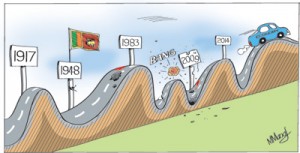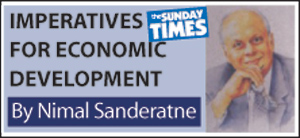Columns
Economic development and structural changes since independence
View(s): The 66 years since regaining independence have been years of structural changes in the economy and economic and social transformations. There have been many achievements as well as emerging concerns. Sri Lanka’s post-independent economic development transformed a predominantly agricultural economy at the time of independence in 1948 into a diversified one where agriculture accounts for only about 11 per cent of national output, services for 59 per cent and industry for 30.4 per cent of GDP. An economy dependent on three agricultural export crops has been transformed into one that exports mostly manufactures.
The 66 years since regaining independence have been years of structural changes in the economy and economic and social transformations. There have been many achievements as well as emerging concerns. Sri Lanka’s post-independent economic development transformed a predominantly agricultural economy at the time of independence in 1948 into a diversified one where agriculture accounts for only about 11 per cent of national output, services for 59 per cent and industry for 30.4 per cent of GDP. An economy dependent on three agricultural export crops has been transformed into one that exports mostly manufactures.
Sri Lanka has attained low middle income status with a per capita income of over US$ 3000 in 2013. Since regaining independence, the economy grew at an annual average of 4.5 per cent. The economy grew at a much higher annual average of 7.5 percent in the post-war period.Unemployment has fallen below 4 per cent and the poverty headcount is 9 per cent. Social indicators have been impressive. In 2012, life expectancy was 75.1 years, infant mortality was as low as 9.4 per thousand (2009) and adult literacy was 92.2 percent in 2011.
Despite these achievements there are serious fundamental economic weaknesses. The high domestic and foreign debt and its onerous debt servicing burden, inadequate export earnings and large fiscal deficits are serious concerns. While recent improvements in infrastructure could contribute to enhanced productivity, inadequate funding of education and health could constrain economic development.
 Economic growth
Economic growth
Although, Sri Lanka’s economy grew at an annual average of 4.5 per cent since independence (1950-2013), there were significant differences in economic growth rates during this period. In the first half of the 1960s, the economy grew at 4.5 per cent per year, while during the second half, under more liberal policies, growth was slightly higher at 4.8 per cent.
The lowest rates of growth were during 1970-77 and 1987-89 when the average annual growth was only 2.8 and 2.2 per cent respectively. Low growth in 1970-77 was due to droughts, the 1971 insurrection, state control and inefficient management of the economy, unfavourable international factors such as food grain shortages, an oil price hike, and unfavourable terms of trade. The low growth in 1987-89 was mainly owing to the insurgency in these years.
Growth and decline 1978-1993
In 1978, consequent to the policy reforms introduced in 1977, the economy grew at 8.2 per cent and at an annual average of 5.9 per cent per annum from 1978 to 1984. Then it declined from 5 per cent in 1985 to 2.2 per cent in 1987-89, due to the ethnic violence in 1983 and consequent internal security conditions. With the restoration of law and order, GDP growth reached 6.2 per cent in 1990 and averaged 5.5 per cent in 1990-93.
Economic performance 1994 – 2004
During 1994-98 the economy grew by an annual average of 5.2 per cent. However, in 1996 economic growth declined to 3.8 per cent from around 5.5 per cent in the two previous years owing to deterioration in security and drought conditions that reduced paddy and food crop production and caused power cuts that disrupted industrial production. Tourism suffered a setback and business confidence weakened. In 1997 the economy bounced back to grow at 6.3 per cent but declined to 4.7 per cent in 1998 due to adverse global conditions.
 During 2000-2004, the economy grew by only 4.0 per cent owing to an energy crisis and LTTE terrorist attacks and the war in the North and East that crippled tourism, agriculture and fisheries.
During 2000-2004, the economy grew by only 4.0 per cent owing to an energy crisis and LTTE terrorist attacks and the war in the North and East that crippled tourism, agriculture and fisheries.
Economic growth 2005-2013
Despite the intensification of the war, there was an upsurge in the economy between 2005 and 2009 with an annual average economic growth of 7 per cent. Since the end of the civil war in May 2009, the economy achieved high rates of growth — 8 per cent in 2010, followed by a growth of 8.4 per cent in 2011. The economy slowed down in 2012 to 6.4 per cent due to the global recession and the withdrawal of the EU’s GSP plus concession that decreased exports, adverse weather conditions and the US embargo on trade with Iran. The economy revived in 2013 to grow by an expected 7.2 per cent. The average annual rate of economic growth in 2010-2013 was 7.5 per cent.
The main sources of growth in the post-war years have been construction, tourism and other services such as communications, trade services, banking and finance. Exports fared badly in 2011-2013, while imports increased sharply. Consequently, trade deficits have been around US$ 9 billion. The strain on the balance of payments has, however, been mitigated by workers’ remittances that offset 60 to 70 per cent of the trade deficit.
Structural transformation
The predominantly agricultural economy at the time of independence has been transformed into a more diversified one. This diversification that was gradual till the late 1970s, gained momentum in the last three decades. Agriculture that contributed 41 per cent of GDP in 1950 accounts for only about 12 per cent of GDP today. At the time of independence manufacturing that consisted mainly of processing tea, rubber and coconut, accounted for only 16 per cent of GDP.
The most notable feature of this structural change is that manufacturing and services make a higher contribution to GDP than agriculture. In 2012, industry contributed nearly 30 per cent of GDP, while agriculture, forestry and fishing together contributed only 11 per cent of GDP and the contribution of services increased to 59 per cent of GDP.
Reflections
The Sri Lankan economy has been and will continue to be an import-export economy though the nature of the external trade dependency will continue to change. Dependency on food imports has been replaced by a dependency on oil and raw material imports whose prices would be an important determinant of the country’s economic future.
There has been an increasing dependence on foreign loans, foreign remittances and earnings from tourism. High fiscal deficits, a large public debt, a large foreign debt, high debt servicing costs and large trade deficits are economic concerns. Future economic development depends very much on an improvement in the country’s economic and social infrastructure; economic and administrative reforms; improvements in the investment climate; increased foreign investment; and above all national unity, peace and harmony and the rule of law.

